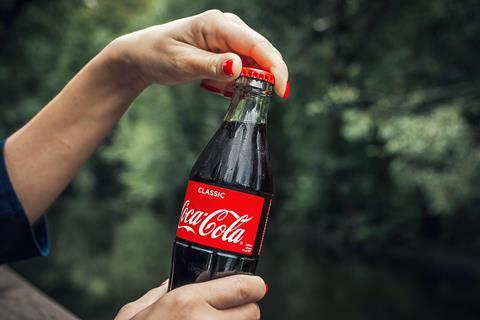With advertising restrictions imminent, it’s becoming more difficult to interest buyers in HFSS products. How are brands responding?
It’s tough being a challenger brand. Tight budgets, long hours, the nagging feeling it could all fall apart at any moment. Things only get harder when targeting a supermarket listing – the clear power imbalance often prompting nervy negotiations and eyebrow-raising requests.
Now, on top of all that, there’s a new dynamic at play. The new HFSS rules set to arrive in October mean many challenger brands are finding it impossible to catch the attention of supermarket buyers, who are reportedly shunning any new products that fall foul of the definition under the nutrient profiling model (NPM).
Ultimately, buyers are all too aware the rules will prevent them from placing these products in prime store locations such as store entrances and aisle ends, or selling them in volume promotions. So for certain buyers, this leads to a simple conclusion: if they can’t promote it, they won’t sell it.
Smaller brands are particularly suffering in this environment. Prodigy Snacks is a “healthy chocolate” supplier that uses reduced amounts of unrefined sugars to remove the need for artificial sweeteners. The business already has listings with Amazon and Ocado, but CEO Sameer Vaswani is now searching out new listings to expand the business.
The problem is, with all of Prodigy’s products falling foul of HFSS laws – therefore prohibiting them from prominent in-store locations and promotions – he’s finding it impossible to get a foot in the door. “Buyers are saying ‘we can’t stock your product if we can’t promote it’,” he says. “In one or two cases it’s been explicit, but mostly it’s been inferred.”
Vaswani is not alone. Flower & White sells chocolate-meringue treats through retailers including Co-op, Selfridges, and Harvey Nichols, but is now struggling to make the same inroads at major supermarkets. “HFSS has become a priority in the buyers’ decision-making,” says MD Brian Crowther. “If the HFSS score isn’t right, the conversation is abruptly stopped.”
The major manufacturers, meanwhile, seem to have largely escaped these issues. For ice cream brands like Ben & Jerry’s, Magnum, and Wall’s, retail conversations are continuing on much as normal, indicates brand owner Unilever – with zero indication their HFSS products could be facing problems.

“Retailers recognise the role of permissible indulgence in ice cream,” says Andre Burger, Unilever VP for food and refreshment in the UK & Ireland. “They are interested in new products that are HFSS.”
It’s unsurprising that Unilever is receiving preferential treatment to challenger brands. The likes Ben & Jerry’s will be a mainstay in the aisles regardless of HFSS rules. Many shoppers will, after all, expect to see these larger brands whether they’re promoted on aisle-ends or not. The same expectation doesn’t apply to lesser-known products trying to carve out a niche.
However, if supermarkets really do cut back on the number of challenger brands in HFSS categories, it raises some important questions for the future of NPD in these aisles. Will the daring innovation provided by challenger brands be lost? Will it all be left to the big guns? And where will NPD efforts focus in the wake of the regulations?
Read more:
-
Four HFSS layout trials underway in UK stores
-
How ready is the food industry for the HFSS clampdown?
-
Four solutions for retailers and brands ahead of HFSS regulations
-
HFSS regulation is a challenge – but it offers fresh in-store opportunities for brands
At some retailers, the early signs certainly suggest a move towards bigger brands. Border Biscuits, for example, says one of the main retailers has removed 60 SKUs from its biscuit category while simultaneously increasing Border Biscuits’ own share.
This comes despite Border fitting very much into the HFSS camp. “We’re not looking to reformulate in any way. Everything is in there to make it taste good and make it that treat,” says MD Paul Parkins. “The reason there’s butter, sugar and chocolate in there is it tastes good, and people want it to taste good.”
Parkins believes that retailers are narrowing down the biscuit category, dropping the “bad” products and giving more room to “accessible premium” brands like Border.
It is an alarming message for many brands if true. While challenger brands will often be capable of fitting into the so-called “accessible premium” bracket, any narrowing of HFSS ranges will inevitably mean a great number lose out.
Time to reformulate?
It’s particularly alarming for brands in categories like chocolate and ice cream, where reformulation isn’t easy – and sometimes impossible.
“Ice cream is a particularly challenging category in terms of reformulation,” says Unilever’s Burger. The role of sugar is “far greater than just taste”, he points out, and is also important for structure.
Even in cases where suppliers can reformulate, it would require hefty use of artificial ingredients. For challenger brands that have prided themselves on natural credentials, it’s a route they want to avoid. “To get HFSS compliance you need to use ingredients that the consumer won’t recognise,” says Crowther at Flower & White.
See Prodigy Snacks, which finds itself in something of a Kafkaesque trap. Having used unrefined sugars to try and make its product “healthier”, it would have to use artificial sweeteners to see its chocolate bars deemed healthy under the NPM. “That’s the only way to bring the sugar down to appropriate levels,” says Vaswani. “I agree you have to reduce our sugar consumption but it’s the type of sugar that’s more important for me,” he adds.
Still, the use of artificial ingredients seems to be the way things are going, if the soft drinks levy is anything to go by. Since its introduction in April 2018, brands big and small have reformulated to duck the tax, which applies to drinks containing more than 5g of added sugar per 100ml. Artificial sweeteners have been key in creating reduced sugar, or zero sugar options.
It means the soft drinks category has had a headstart on the HFSS clampdown. The majority of brands already have popular compliant lines that are ready to fill promotional space.

At Coca-Cola Europacific Partners (CCEP), for example, two-thirds of its drinks volumes are already low or no sugar varieties – a figure boosted by 100 new low or no sugar soft drinks since 2010 and 47 reformulations over the same period, according to Oliver Crick, CCEP’s category development director.
As a result, the company has reduced its overall sugar use by 25% since 2015, which means that come October when HFSS laws come into force, 86% of its soft drink brand ranges will be non-HFSS, says Crick.
That doesn’t mean the soft drinks giants are resting on their laurels when it comes to compliant innovation, though. In response to the impending HFSS deadline, CCEP has already confirmed Capri-Sun will be reformulated across its Orange, Tropical and Blackcurrant flavours, while the company is also rethinking its entire in-store marketing programme to try and boost sales once the new laws arrive.
CCEP will clearly be able to take advantage of the promotional space that is freed up once HFSS brands are banned from prominent areas. It’s not only looking to simple solutions like gondola ends, though, but thinking carefully about its in-store strategy.
In the alcohol aisle, for example, CCEP has placed its Schweppes range within touching distance of vodka and gin SKUs, and Crick believes a similar stunt could see Coca-Cola placed alongside chilled pizzas.
The lesson seems to be that, if you can reformulate, it pays off. So non-HFSS innovation has become a priority for a number of categories – even in those that seem intrinsically unhealthy, like pizza.
Non-HFSS innovation
Goodfella’s, for example, has reformulated more than half of its range to fall inside the HFSS guidelines as it seeks to continue cashing in on valuable in-store promotions. “While we play in a category that is automatically associated with indulgence, our R&D team have been able to renovate and innovate numerous non-HFSS pizza products,” says Lauren Woodley, group nutrition leader at brand owner Nomad Foods.
“Our focus remains on how we can integrate more positive nutrients and ingredients, without compromising taste or quality, while also addressing the classic nutrients of concern.”
“Our focus remains on how we can integrate more positive ingredients, while also addressing the classic nutrients of concern”
It’s a similar story in crisps. Walkers, for example, has now unveiled its first fully non-HFSS crisps range which contain “nearly half the salt” of its standard offering, KP Snacks plans to reformulate Tyrrells, Popchips, Hula Hoops Puft and Penn State products to make them HFSS-compliant, while PepsiCo this week confirmed its Doritos and Popworks lines will be reformulated too.
It’s not just the big brands have the clout here. Many challengers – particularly in snacking – have developed non-HFSS ranges to catch the eye of retailers. See healthy snacking startup Mindful Snacker, which launched an eight-strong range of non-HFSS crisps last April. It invested in a £20m kit to produce the potato crisps without any compromise on flavour.
Flavour challenge
The question is: can these innovations take place across the board without sacrificing the flavour? Some are sceptical. “Meeting government guidelines alone will only get you so far from a consumer perspective,” says Sarah Smart, CEO of yoghurt maker The Collective UK, whose core range is 80% non-HFSS.
For her, a combination of taste and added benefits will be key. “People still expect delicious, exciting eating experiences and will be drawn to those brands that are able to deliver this in addition to providing positive health benefits,” she says.
With this in mind, some brands have decided not to worry about the HFSS rules and bet purely on indulgence instead. At Nu, for example, country manager Paul Sloane is confident the chocolate and protein bar supplier will maintain its foothold in the supermarkets. “The shopper and consumer will demand a full range of products – not just HFSS-compliant products – and the retailer will look to supply products that meet a total range,” he says.
Suppliers hope retailers will also continue to support products that promote portion control, rather than focusing on HFSS compliance. The HFSS definition revolves around the NPM, which rewards positive nutrients and punishes negative ones. Unilever’s Burger points out it doesn’t take into account healthier, portion-controlled options that have been popular with retailers – like snacking formats and mini ice creams.
“The way legislation is structured doesn’t recognise portion sizes as a very positive way to drive public health,” Burger says. “The issue many manufacturers have is that the model is based on the assumption of 100g consumed.”
This means manufacturers have less incentive to release new products with smaller portions – something that has been a focus of NPD efforts until now. While Unilever has relayed its concerns to the government, it doesn’t expect the situation to change soon.
“I think there’s an understanding around where some of the potential gaps are in terms of the NPM, but I don’t think there’s momentum to change that,” Burger says. “There are improvements to be made that will incentivise manufacturers in the right way,” he adds. “The current regime is a fairly blunt one.”
On the plus side, the rules could incentivise much grander research efforts from companies in the long term. The aforementioned Mindful Snacker brand is just one example of serious investment in innovation.
Urban Legend, for example, is a ‘healthy’ HFSS-compliant doughnut brand, ‘setting’ its doughnuts by steam rather than deep-frying them – a move that has helped halve the product’s sugar and fat compared with some of its competitors.

“When I started it, I wasn’t sure it was achievable,” says Anthony Fletcher, the company’s founder. “Having done it I think this is a possible golden age of innovation to come. I’m a super-optimistic for a new set of opportunities that are yet to be discovered.”
Fletcher advocates taking an R&D mindset than the kind of product development common in the food industry. “It’s about the extent to which you’re going to engage in fundamental science,” he says.
Unilever’s Burger agrees, pointing to the company’s R&D facility in Wageningen in the Netherlands, which he nicknames ‘the Silicon Valley of the food industry’.
Its a reminder of the stark difference facing suppliers as they prepare for the upcoming HFSS ban. While the likes of Unilever have been preparing for years for the changes, others are getting rebuffed by supermarkets just as they start to find their stride though. Those who have innovated ahead of time will undoubtedly have an advantage.
Perhaps most striking though, is the fifth of suppliers reportedly unaware the new rules are coming, according to GS1. For those companies, a bumpy landing now seems inevitable.




















No comments yet